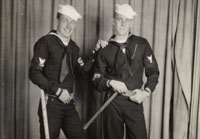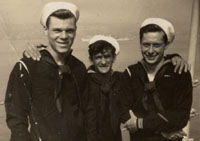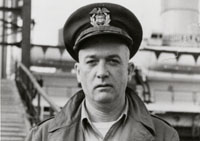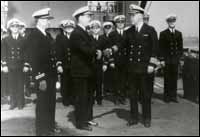Chapter 7: The Story – Dead Reckoning
Rescue, Part I – The Pollux
At Lawn Point, Greenfield and DeRosa were huddled in the clump of trees at the top of the cliff, while Garnaus explored the surrounding area. Suddenly, he saw the figure of a man descending some hills in the distance. Could help have finally arrived? He hurried toward the approaching figure and discovered it was Lionel Saint – the St. Lawrence man who had seen debris washing in from the west while at the site of the Truxtun.
Up until then, neither Garnaus nor any of his shipmates knew that the Truxtun had also gone aground. It was a shocking discovery, but there was little time to absorb the news – more than 100 men were still trapped onboard the Pollux or on the rocky beach below. Saint immediately directed Garnaus to Iron Springs Mine, which was about a five-mile walk away – the sooner the men could reach the mine, the sooner they could summon more help from St. Lawrence. Garnaus went back to fetch Greenfield and DeRosa and discovered that two other sailors had joined them in the clump of trees. The five survivors immediately departed for Iron Springs with Saint leading the way. It would be about a three-hour walk through the howling wind and hip-deep snow drifts, but it was their best chance of survival.
As they departed, a plan was hatching onboard the Pollux to secure a line from ship to shore. Some of the men who abandoned ship had landed near a rocky ledge that lay about 65 feet from the sinking ship. If the men onboard could throw a line to their crewmates on shore, then they could rig a breeches buoy. Lieutenant William Grindley went below deck and returned with a fishing line that had a telephone receiver tied to one end. If they could throw this to a man on shore, they could create a breeches buoy.
But there was a problem – in order to catch the line, one of the survivors would have to crawl over a narrow and icy ridge to reach the part of ledge that lay closest to the ship. Whoever volunteered to do that would risk his own life – the ridge was slippery and there was a very real possibility that whoever tried to cross it would fall into the same churning waters that had just killed more than 80 of his fellow sailors. For a while, no one volunteered. But after a few moments' deliberation, and to the tremendous relief of the men still onboard the Pollux, Alfred Dupuy courageously stepped forward – and in his bare feet, no less, having lost his shoes in the ocean.
“Nobody would go, so I said, ‘Well hell, I'll go,’” he later remembered. “So I started. I got on my hands and my knees. I was afraid. What I was afraid of was that there would be crevices or holes, and hell, I'd step in one and be gone. But I could feel them as I crawled, so I crawled across the reef and edged down the reef as far as I could go. I could have gone a little further, but it was a solid sheet of ice and then the ocean.” (Tape 71, 9:11-9:56) Finally, after an agonizing heart-stopping eternity, Dupuy reached the ledge, stood up, and waited for the men onboard to throw him the line.
Grindley swung the telephone receiver around his head and sent it soaring through the air. A catch on the first try! As Dupuy began to pull in the line, the men onboard attached a heavier rope to the other end, which would be strong enough to support a breeches buoy. Pulling in all that weight was difficult – Dupuy's hands were numb and his body exhausted. Unable to feel the oil-caked rope, he had to pull it in with his teeth and the palms of his hands. It was slow, excruciating work, but the lives of his shipmates depended on it.
Finally, Dupuy hauled in enough rope to wrap it twice around a boulder. Another man, Melvin Bettis, crossed the ledge and helped him tie the knot. The line was taut and seemed strong enough to support a breeches buoy. Because of Dupuy's and Bettis's astounding heroism, the other men on the Pollux now had a way off the ship.
The sailors quickly rigged a breeches buoy and tested it by sending some canned food and dry clothes to the ledge. It worked! But could it hold the weight of a man without dropping him into the raging ocean below? Edgar Brown volunteered to find out. Six feet tall and built like a football player, Brown figured that if the line could carry him, it could carry anyone. Risking his own life, he entered the breeches buoy and began to slide over the line. It sagged quite a bit under his weight, but held firm – Brown reached the ledge without even getting his feet wet. It was about 2:30 in the afternoon and the first major success of the day for the crew of the Pollux.
One by one, the men entered the breeches buoy and one by one they landed on the ledge. Each survivor carried with him blankets, food, or other supplies that would help the freezing men who had swum to shore. After about two hours, only one man was left onboard the Pollux. It was the ship's captain, Commander Turney. As he entered the breeches buoy and slid along the line, his crew on shore gave up a tremendous applause. By 4:30, there were about 122 men standing on the ledge and no one left in the disintegrating Pollux.
After the initial excitement faded, the men realized that their ordeal was far from over. Towering above them was an ice-covered cliff that would be impossible to climb. Worse, the tide was coming in and the already crowded ledge was about to get much smaller. With no way up the cliff, all the men could do was wait and hope like crazy that help was on its way.
From Lawn Head to Iron Springs
While the men were evacuating the Pollux, Garnaus and his five companions were walking toward Iron Springs Mine in St. Lawrence. It was a long and arduous trek over hills and through deep snow. At one point DeRosa collapsed, exhausted and delirious. Greenfield stayed behind to try and revive him, while the other men pressed on. Despite his efforts, however, nothing could be done for the young sailor – DeRosa died that afternoon in the snowdrifts between Lawn Point and Iron Springs Mine. It was a blow for Greenfield, but if he stayed by his shipmate any longer, he would surely freeze to death. Standing up, he followed in the footprints made by the other men.
Further ahead, Garnaus and Saint had reached Iron Springs Mine, where they shocked everyone with the news that a second vessel had gone aground. Many of the men present had spent hours at the Truxtun site, pulling survivors out of the water and over the cliffs. Without hesitation, however, the exhausted men went back into the cold and started out on the long trek to Lawn Point. Word was sent to St. Lawrence that a second ship had gone aground and that even more clothes, food, and volunteers were needed to take part in the rescue effort.




